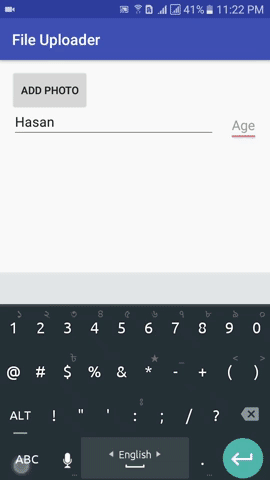Android-File-Upload-To-Server
 Android-File-Upload-To-Server copied to clipboard
Android-File-Upload-To-Server copied to clipboard
Check my Bengali tutorial post of Android File Upload service from this URL
Image or any File Upload to Server using Retrofit in Android App
We'll design this type of sample Android App using Retrofit Android Library:

Create instance of Retrofit class (You can check basic Retrofit implementation from here)
public class RetrofitApiClient {
private static final String BASE_URL = "http://yourdomainname.com"; //I used IP of my local machine
private static Retrofit retrofit = null;
private static Gson gson = new GsonBuilder()
.setLenient()
.create();
private RetrofitApiClient() {} // So that nobody can create an object with constructor
public static synchronized Retrofit getClient() {
if (retrofit==null) {
int timeOut = 5 * 60;
OkHttpClient client = new OkHttpClient.Builder()
.connectTimeout(timeOut, TimeUnit.SECONDS)
.writeTimeout(timeOut, TimeUnit.SECONDS)
.readTimeout(timeOut, TimeUnit.SECONDS)
.build();
retrofit = new Retrofit.Builder()
.baseUrl(BASE_URL)
.addConverterFactory(GsonConverterFactory.create(gson))
.client(client)
.build();
}
return retrofit;
}
}
The Interface class is given below:
public interface ApiInterface {
@Multipart
@POST("file_upload_api/upload.php")
Call<ResponseModel> fileUpload(
@Part("sender_information") RequestBody description,
@Part MultipartBody.Part file);
}
File upload method is here:
public static void fileUpload(String filePath, ImageSenderInfo imageSenderInfo) {
ApiInterface apiInterface = RetrofitApiClient.getClient().create(ApiInterface.class);
Logger.addLogAdapter(new AndroidLogAdapter());
File file = new File(filePath);
//create RequestBody instance from file
RequestBody requestFile = RequestBody.create(MediaType.parse("image"), file);
// MultipartBody.Part is used to send also the actual file name
MultipartBody.Part body = MultipartBody.Part.createFormData("file", file.getName(), requestFile);
Gson gson = new Gson();
String patientData = gson.toJson(imageSenderInfo);
RequestBody description = RequestBody.create(okhttp3.MultipartBody.FORM, patientData);
// finally, execute the request
Call<ResponseModel> call = apiInterface.fileUpload(description, body);
call.enqueue(new Callback<ResponseModel>() {
@Override
public void onResponse(@NonNull Call<ResponseModel> call, @NonNull Response<ResponseModel> response) {
Logger.d("Response: " + response);
ResponseModel responseModel = response.body();
if(responseModel != null){
EventBus.getDefault().post(new EventModel("response", responseModel.getMessage()));
Logger.d("Response code " + response.code() +
" Response Message: " + responseModel.getMessage());
} else
EventBus.getDefault().post(new EventModel("response", "ResponseModel is NULL"));
}
@Override
public void onFailure(@NonNull Call<ResponseModel> call, @NonNull Throwable t) {
Logger.d("Exception: " + t);
EventBus.getDefault().post(new EventModel("response", t.getMessage()));
}
});
}
Here I used EventBus Library to notify my UI from a different class. The simple implementation of EventBus is given here.
I used my local machine as a server (localhost). To do so, I created a folder file_upload_api in my www>html folder (for Linux). Inside this folder I created a folder files. This folder will contain my uploaded images. Then put a PHP script as a sibling of files folder. Here I mention the upload.php code:
<?php
$target_dir = "files/"; //folder name where your files will be stored. create this folder inside "file_upload_api" folder
$target_file = $target_dir . basename($_FILES["file"]["name"]);
$response = array('success' => false, 'message' => 'Sorry, there was an error uploading your file.');
$data = $_POST['sender_information'];
$json_data = json_decode($data , true);
$sender_name = $json_data['sender_name'];
$sender_age = $json_data['sender_age'];
if (move_uploaded_file($_FILES["file"]["tmp_name"], $target_file))
$response = array('success' => true, 'message' => 'Hello '.$sender_name.'! You are '.$sender_age.' years old. Your image is uploaded successfully!');
echo json_encode($response);
?>
Disclaimer
This PHP script cannot handle a large file. If you upload a tiny image it'll work fine. But for any large image you'll get error message. To upload large image file please search on Google.